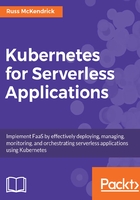
Stop and delete
As we are running our single-node Kubernetes cluster as a virtual machine on your host, you may not want it running all of the time, using resources.
There are two options to achieve this, the first of which is minikube stop. This command will stop your node and keep the virtual machine intact. You should use this command if you plan on picking up where you left off when you next start your node by running minikube start.
While the minikube stop command stops your virtual machine from using CPU and RAM resources on the host machine, the hard disk image used to host the virtual machine will still be present on your machine. While a freshly launched cluster does not take much space on the host hard drive, on my macOS installation it is around 650 MB; as soon as you start to use the cluster, you may find that this space will at least double.
This is where our next command comes in. The minikube delete command will remove the cluster completely, including all of the virtual machine files, freeing the space used on the host machine.
At the time of writing, running minikube delete will immediately remove your machine, running or not. There is no prompt asking if you are sure, or any way back from the command (unless you have backups), so please ensure that you use this command with caution.
When you run minikube start again, your cluster will be started from scratch again, as we first experienced in the previous section.